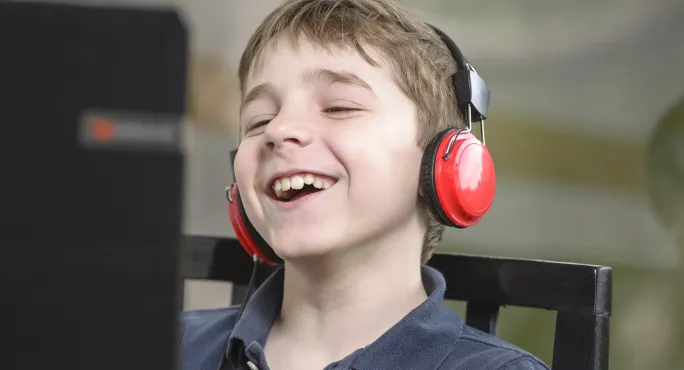- Home
- Analysis
- Specialist Sector
- How to help ASN pupils by making small changes to classrooms
How to help ASN pupils by making small changes to classrooms

We know the impact that our environment has on how we feel: the people we are with, the noise, the light, the layout of a space will all affect how we engage with our surroundings.
Through our work with the Inclusion Ambassadors group - a group of secondary school-aged students who have a range of additional support needs (ASN) - we have regularly covered how different aspects of a learning environment affect experiences of school, both in terms of how pupils feel about being there and how they support their learning or otherwise.
Ultimately, if the learning environment is not inclusive, it has an impact on a child’s right to education. Getting the environment right is also central to realising the Inclusion Ambassadors’ vision statement for additional support for learning.
Creating inclusive classrooms for ASN pupils
What does an ideal learning environment look like?
Through a series of online and in-person meetings, we have explored the sensory environment, the layout of the classroom, the technology available and how staff act. Based on what the Inclusion Ambassadors have told us, we now have a new visual resource (see the link at bottom of this article) to help teachers and other school staff create a learning environment that pupils want.
What the group told us is not necessarily difficult to implement, yet for too many it is not a reality. Too often “traditional” ways of doing things get in the way of what would help pupils have more positive experiences of school and support their learning. We need to consider the needs of individuals - one-size-fits-all approaches do not work.
- Related: “We know how to make inclusion work - so let’s do it”
- ASN tribunals: Legal insight for teachers and school leaders
- Opinion: ASN pupils must no longer be seen as a “costly afterthought”
A more relaxed environment
We know that a busy classroom can generate a lot of noise, and many asked for more awareness of how this can impact on those with support needs. Some adjustments can be made for pupils, such as providing noise-cancelling headphones or allowing them to listen to music.
The ambassadors welcomed approaches that would accommodate sensory needs, such as being allowed to use fidget toys or stress balls to help with concentration. A quiet corner and soft furnishings would also help the classroom feel like a safe space. Many also recommended dimmer lights, as bright lighting can be overstimulating.
Access to technology
Awareness of supportive technology, and its availability in classrooms, is crucial for inclusion. Tablets and educational apps can make learning more accessible, as can specialist IT support.
Schools need to ensure a range of provision is available for pupils who need additional support. A number of organisations, such as Call Scotland, can offer supportive technologies and provide information about what works. We found many ambassadors were unaware of the resources available, and we would encourage schools and local authorities to take advantage of this support.
Classroom set-up
The Inclusion Ambassadors spoke about the impact of the physical environment of the classroom and a desire for more flexibility in how classrooms are laid out. They highlighted the importance of considering accessibility and being mindful that some pupils may need extra space to move around, given their mobility or sensory needs.
More boardroom-style classroom layouts were preferred because they were perceived to offer the teacher a better view of the room and the pupils, leading to less bullying in the classroom. The ambassadors also voiced appreciation for when pupils’ work was used to decorate the walls.
Teachers and support staff
Crucial for inclusive teaching are approaches that build on the needs and wants of the pupil. The Inclusion Ambassadors want teachers and other school staff to be approachable, kind and welcoming, to be interested in the lives of pupils and to build meaningful relationships with them. This can easily be done through encouraging, friendly conversation. Many spoke of how teachers who shout can make pupils feel scared or anxious.
All of this advice above reflects what Children in Scotland has found in previous work for the General Teaching Council for Scotland professional standards, while Children in Scotland podcasts have looked at what makes a good pupil support assistant.
Our new visual resource (see the link below) is aimed at being a helpful reminder for school staff about what children and young people want, based on evidence from the Inclusion Ambassadors.
Implementing these approaches across all schools would be a key step towards embedding a rights-based approach to education. It shows trust and respect for pupils and places them at the centre of their learning environment.
What’s more, by taking these steps to make classrooms and school environments more inclusive, we are certain they will become safer, happier spaces for everyone.
Chris Ross is senior policy, projects and participation officer at Children in Scotland. This is a version of an article that originally appeared on the Children in Scotland website
The Inclusion Ambassadors’ new visual resource can be found here
You need a Tes subscription to read this article
Subscribe now to read this article and get other subscriber-only content:
- Unlimited access to all Tes magazine content
- Exclusive subscriber-only stories
- Award-winning email newsletters
Already a subscriber? Log in
You need a subscription to read this article
Subscribe now to read this article and get other subscriber-only content, including:
- Unlimited access to all Tes magazine content
- Exclusive subscriber-only stories
- Award-winning email newsletters



